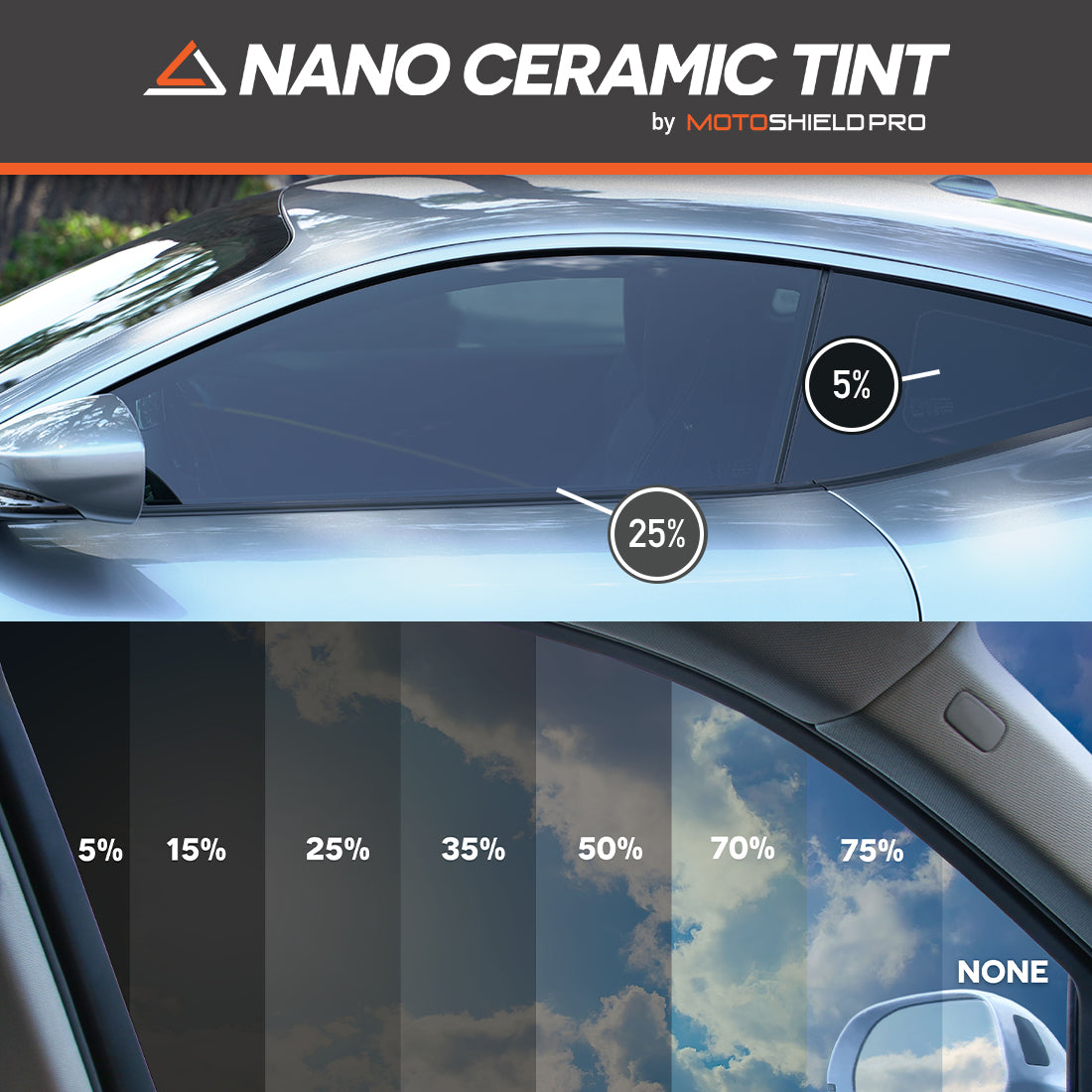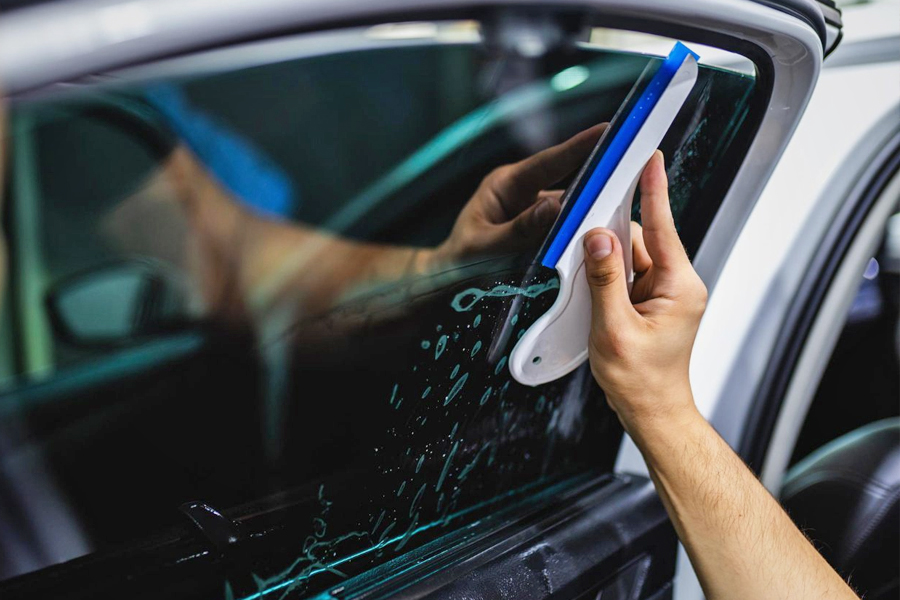A Comprehensive Guide to Solutions Offered With Window Tint Solutions
Home window tinting has come to be an essential service for both household and industrial settings. It uses various movies designed to meet certain needs, such as warm reduction and privacy enhancement. Comprehending the series of options offered is essential for making informed choices. This guide will explore the different kinds of home window tinting movies, their benefits, and the setup procedure. It will certainly also attend to legal considerations that may impact your options. What variables should one take into consideration before proceeding?
Sorts Of Home Window Tinting Films
Window tinting films can be found in various types, each designed to fulfill particular needs and preferences. One of the most usual types include dyed, metalized, ceramic, and hybrid films. Dyed movies offer a basic degree of personal privacy and warm decrease, making use of a dye layer to take in warmth. Metalized movies include tiny metal fragments, providing boosted heat being rejected and glow reduction while additionally adding durability. Ceramic films stick out for their premium performance, as they obstruct warm without hindering signal transmission, making them ideal for digital devices. Crossbreed movies integrate aspects of both dyed and metalized films, providing a balance in between visual charm and functional benefits. Each movie type varies regarding light transmission, UV defense, and guarantee options, enabling consumers to pick a solution that straightens with their certain requirements and design choices. Comprehending these choices is essential for making an educated decision when considering home window tinting services.
Advantages of Residential Window Tinting
Residential window tinting offers a variety of advantages that boost both comfort and energy effectiveness in homes. One of the main benefits is the decrease of heat gain, which brings about lower energy bills by lessening the reliance on air conditioning systems. In addition, window tinting aids to block unsafe UV rays, securing both inhabitants and furnishings from sunlight damages and fading.Moreover, it enhances privacy without jeopardizing all-natural light, allowing house owners to enjoy their views while keeping spying eyes away. The application of home window film likewise boosts safety and security by holding shattered glass in location throughout crashes or storms, consequently decreasing injury risks.Furthermore, property home window tinting can add to a more aesthetically pleasing exterior, as various movie alternatives are available to match different architectural styles. Generally, these advantages make window tinting a valuable and sensible investment for property owners seeking improved livability and energy effectiveness.
Benefits of Commercial Window Tinting
While numerous services seek methods to improve their workplace, industrial window tinting supplies a wide variety of benefits that can considerably improve both worker comfort and functional performance. One main benefit is the reduction of glow, which can greatly improve productivity by permitting employees to function without disturbances from rough sunshine. In addition, window tinting can assist regulate interior temperatures, leading to lowered reliance on a/c and lower power costs.Furthermore, colored home windows supply UV security, protecting employees and furnishings from unsafe rays that can trigger skin damages and discolor materials. This security not only adds to a healthier workplace but likewise extends the life of office insides. Ultimately, business window tinting can boost personal privacy, enabling services to preserve a specialist appearance while minimizing outdoors distractions. In general, these benefits make industrial window tinting a beneficial financial investment for organizations intending to enhance their workspace.
The Home Window Tint Setup Process
A successful window color setup procedure includes a number of essential steps to guarantee excellent results. Originally, the area and windows must be extensively cleaned up to remove dust, oil, and any type of various other impurities that might affect attachment. Next, the tint film is carefully determined and cut to fit the details dimensions of each window.Following this, the installer uses a service to the glass surface to permit repositioning of the movie before it adheres. The movie is after that placed onto the window, making certain it is without bubbles and wrinkles. Once positioned correctly, a squeegee is made use of to get rid of excess water and air.Finally, the sides of the film are trimmed for a neat finish, and the installation is inspected for top quality. Correct attention to these actions guarantees the durability and performance of the window tint, improving both aesthetics and performance.
Upkeep and Look After Your Home Window Color
How can one ensure the durability and appearance of window color? Appropriate upkeep and treatment are essential. It is advised to wait at the very least 30 days after installation prior to cleaning the color to allow for correct attachment. As soon as this period mores than, utilizing a soft cloth or microfiber towel can stop scrapes while cleaning. Mild, ammonia-free cleaners need to be used to stay clear of harming the film.Regular assessments of the sides and surface area can help determine any type of bubbling or peeling early, enabling prompt repairs. Avoid utilizing unpleasant materials or severe chemicals that could degrade the tint. In addition, vehicle parking in shaded areas or utilizing sunshades can lessen UV direct exposure, more shielding the color's integrity.
Lawful Considerations for Window Tinting
Lawful factors to consider for window tinting differ significantly throughout different states. Each state has details guidelines concerning visible light transmission limits, which dictate just how much light can go through tinted windows. In addition, some states offer clinical exceptions, permitting individuals with particular problems to utilize darker tints than normally permitted.
Tinting Laws by State
While window tinting can improve a vehicle's aesthetics and give added privacy, it is essential for car owners to understand the varying guidelines that control tinting across various states. Each state has its own certain laws relating to the allowable levels of color darkness, representation, and the types of home windows that can be tinted. For circumstances, some states permit darker colors on back home windows however impose more stringent restrictions on front side home windows. In addition, specific states may require certain tags or certificates to validate compliance. Falling short to comply with these policies can cause fines or the need to remove the color (Davinci of Michigan Window Tinting). Lorry owners should research their state's laws before investing in window tinting services.
Noticeable Light Transmission Purviews
Comprehending the noticeable light transmission (VLT) limitations is important for any individual thinking about home window tinting. VLT describes the percentage of visible light that can travel through the tinted glass. Different states have varying guidelines pertaining to acceptable VLT degrees, particularly for different home windows in vehicles. As an example, front windshields usually have more stringent limits contrasted to side and back home windows. Breaking these laws can result in penalties and the requirement to eliminate non-compliant tinting. As a result, it is essential for people to research their state's particular VLT regulations prior to waging window color installment. Compliance warranties not just legal adherence but additionally security and exposure while driving, visit this web-site advertising a more secure environment for all roadway users.
Clinical Exceptions for Tinting

Selecting the Right Home Window Tinting Solution
Choosing the right window tinting service entails a mindful assessment of private tinting demands. It is important to review various solution choices, ensuring they align with the wanted results. Additionally, comprehending the legal laws governing home window tinting can help stay clear of possible problems down the line.
Examining Tinting Requirements

Reviewing Service Options

Recognizing Legal Regulations
Prior to choosing a home window tinting service, people have to comprehend the legal guidelines governing tinting in their area, as these legislations can differ significantly between municipalities and states. Each territory might enforce particular constraints on the allowable tint darkness, reflective properties, and which home windows can be tinted. Some states might permit darker tints on rear home windows while banning them on front home windows. Additionally, laws often describe the types of products that can be made use of and may need specific labeling or qualification. Failure to follow these regulations can cause penalties or the need to remove the color. Subsequently, potential consumers ought to validate the validity of their wanted tint and get in touch with experts acquainted with neighborhood legislations to guarantee compliance.
Frequently Asked Concerns
Exactly How Long Does Home Window Tinting Commonly Last?
The durability of home window tinting generally ranges from five to 10 years, depending upon variables such as the high quality of the film, setup process, and ecological problems. Regular maintenance can additionally affect its lifespan substantially.
Can Window Tinting Be Removed Easily?
The simplicity of home window color removal relies on the installation technique and sticky utilized. Commonly, specialist services ensure much safer, cleaner removal, while do it yourself attempts might result in damage to the glass or glue residue.
Will Home Window Tinting Influence My Home's Resale Worth?
Home window tinting can influence a home's resale worth positively or negatively. Possible purchasers may value energy financial savings and personal privacy, while others may view it as a personal preference, affecting overall allure and worth of the property.
Exist Eco-Friendly Home Window Tinting Options Available?
The inquiry about environment-friendly window tinting options exposes that numerous producers currently use items making use of lasting products. These choices can reduce power intake and boost comfort while lining up with eco mindful methods in home renovation.
Can Home Window Tinting Assist With Power Efficiency?
Window tinting can greatly improve energy efficiency by lowering heat gain and loss. This helps keep comfortable interior temperature levels, possibly decreasing heating & cooling prices, while additionally adding to a more lasting setting with minimized energy consumption. The application of window film likewise improves security by holding destroyed glass in place throughout mishaps or storms, therefore decreasing injury risks.Furthermore, domestic home window tinting can contribute to an extra visually pleasing outside, as numerous movie alternatives are offered to match different architectural styles. Furthermore, home window tinting can help manage indoor temperatures, leading to reduced dependence on air conditioning and reduced energy costs.Furthermore, colored windows supply UV defense, securing employees and furnishings from harmful rays that can cause skin damages and fade materials. Some states permit darker colors on back home windows however impose more stringent limits on front side home windows. Prior to selecting a window tinting solution, people need to comprehend the legal guidelines regulating tinting in their area, as these legislations can vary significantly between states and municipalities. Some states might allow darker colors on rear windows while banning them on front home windows.